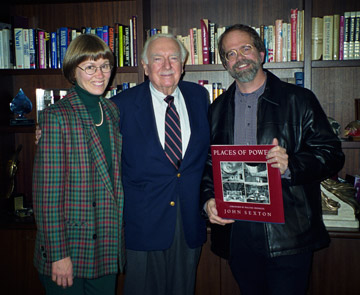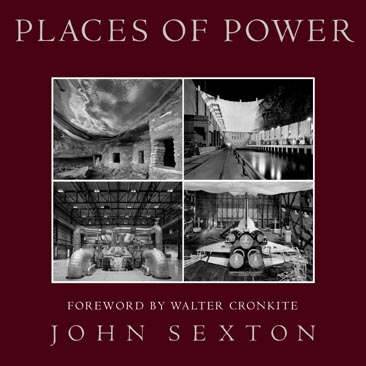REMEMBERING WALTER CRONKITE
John Sexton and Anne Larsen with Walter Cronkite With the recent passing of legendary broadcast journalist Walter Cronkite John thought it might be of interest to visitors to this web site to read Mr. Cronkite's foreword, which he contributed to John's book Places of Power. John was most honored and humbled to have Mr. Cronkite contribute his essay, A Journey Through Time, as one of the introductory texts to his book. The foreword is included in its entirety below.
by Walter Cronkite The central story of any age is largely that of its technology, according to the history textbooks. In school, students study bygone eras emblazoned with muscular names such as the Stone Age, the Iron Age, and the Age of Steam. They learn that the Dark Ages were dark because the light of human advancement seemed to grow dim. Conversely, the Renaissance was a golden age when science flourished and the artist Leonardo da Vinci doodled daydreams of flying machines in his sketch pad. The second half of the 20th Century, the era I have had the privilege of chronicling, was called the Space Age and with good reason. A millennium from now the preeminent story of our time will be that we broke free from our terrestrial environment and landed the first man on the moon. It’s a chapter in history as exciting as the building of the pyramids or Columbus sailing to the New World. For those of us who were there, it was impossible not to be swept away by the grandeur and audacity of it. I had as much time to prepare for that lunar adventure as NASA did; and yet when the Eagle landed, all I could say before a world television audience was, “Oh boy ... whoo.” And while the story of human technology is riveting and makes for terrific headlines, it is troubling as well. Our technological advances have almost always created new, unanticipated problems. In Places of Power John Sexton examines that complex story and through his unerring eye we experience the unexpected — clean, startling beauty combined with a subtle warning out of the past for those who build toward the future. What Sexton offers here is a journey through time, beginning with the remains of Anasazi sites which have stood the test of centuries. We see the present in unique images of power plants and Hoover Dam. Then, wielding his camera with the precision of a surgeon, he searches out the future, examining the technology of the Space Shuttle. From a visual standpoint, the stories of our time and the Anasazi share a compelling parallel. In both cases the technology — ancient and contemporary — embodies remarkable beauty. The spare, perfect lines of the ancient cliff dwellings and the gigantic, austere sweep of Hoover Dam are canvasses where human aspirations are painted large. The now-silent Anasazi sites still emanate a spiritual “power,” while the pulsing power of a modern steam turbine can make the earth shake while generating almost unimaginable quantities of electricity. The Anasazi's epic tale and the story of twentieth century technology also share a deeper, disquieting connection. Some archaeologists now believe that the Anasazi were forced to abandon their deftly-built cliff dwellings in part because their numbers grew too large and they had depleted the surrounding area’s natural resources. As a result, at least 30,000 people were forced to find a new homeland several hundred miles away. In our own time that ancient story is being retold on a global scale. The challenges today are more daunting. Now that our numbers are growing into the billions and we are depleting our resources at a frantic pace, where will we go? Today’s “Space Age Technology” does not offer a promise in the foreseeable future for humankind to escape our small planet en masse to search out a new homeland. Yet Sexton’s lens is not just playing the role of Cassandra, calling out warnings of eschatological calamity. This is a story with a twist. Those who designed Hoover Dam, the power plants, the Space Shuttle, and even the Anasazi structures set out simply to create things that would serve a practical purpose. However, when we see these utilitarian objects through John Sexton’s eyes, they become as exotic and exciting as sculpture gardens. The builders set out to create things of strength and, without intending to do so, created things of beauty. Sexton’s artistry illuminates the idea that within humanity’s dreams and intellect there exists a divine spark. His photographs reveal a beauty that is intertwined with our collective imperfections — a transcendence that flows through our science, a ghost of divinity in our machines — a beauty so intelligent and so deeply bundled into our mental sub-systems that it actually offers a moment of hope for the future. As I wrote in my autobiography, A Reporter’s Life, “We have been present at the birth of the nuclear age, the computer age, the space age, the petrochemical age, the telecommunications age, the DNA age ... the new technologies give proof of the human being’s intellectual capacity. Can we really believe that we are incapable of applying that same intellectual power to solving the great problems the world faces ...?” Just as the builders of the objects photographed in Places of Power could not foresee the full scope of their work, we today cannot see where the plot line of the new century, or the new millennium, will take us. In all likelihood that story will involve a societal evolution that will take the form of upheaval. Those who control technology today will lose that control in some coming revolution, and those who steal the new Promethean flame will do so because they have the strength of humanity’s dreams and intellect behind them. The Space Age will be replaced by another age, one we cannot imagine. We can only hope that what remains of today’s Space Age marvels — little more than a few lovely artifacts, no doubt — will somehow guide tomorrow’s civilizations toward a finer future than that which we can envision today. ©2000 John Sexton. All rights reserved
Places of Power is currently out of print. Used book dealers are selling Places of Power at prices above and beyond the normal retail price. If by chance you're interested in purchasing an autographed copy of Places of Power, they are available until August 31st for the special price of $80 at the Ventana Editions online store.
©2009 John Sexton. All rights reserved Site last updated August 3, 2009
|
|
|

